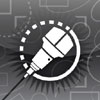Plan. In Plan mode, the drawings are laid out flat, like sheets of paper on a drawing board or a table. This is the conventional CAD arrangement. The drawing can be one page or lots of pages, but however many there are, they will always lay flat alongside each other.
You can have multiple transparent layers to a Plan drawing, which is a powerful tool for complex drawings where it is convenient to superimpose one layer upon another. For example in a working drawing of a yacht, in the plan view, we might have the following layers to a drawing
Layer 5: Electrical systems
Layer 4: Plumbing systems
Layer 3: Interior furniture
Layer 2: Engine installation
Layer 1: Basic structures
Such an arrangement helps identify possible conflicts between systems and gives a sense of the three-dimensional aspects of the vessel. And because each layer can be visible or hidden, we can work on the different systems independently of each other, or in conjunction with any or all of the other layers. And we can issue each layer to the installing engineers or boatbuilders as a separate technical drawing.
Another common use of layers is in drawings where the main part of the drawing is at one scale (say 1:10) and detail excerpts at another (say 1:2). Even though the two components occupy different places on the drawing (so don't require superimposition), it is very convenient to keep them on different layers so you don't have to keep changing scales. Because both layers can be visible at the same time, the drawing can be issued as one complete whole.
Although you can have as many pages to a Plan mode drawing as you wish, it is common to make your paper size and drawing size the same, so that you have just one (maybe quite large) page.
For further information regarding working with Layers see Window >> Layers/Pages.
Workbook. In Workbook mode, which is unique to RealCADD, the drawings are laid out on top of each other, like sheets of paper on a clipboard or in a loose-leaf folder.
As with a book, and unlike layers, you can't look through one page to the page beneath, so the format is not especially good for complex drawings where transparent layers are useful. And, the "Layers" in Workbook mode are called "Pages" to reflect this fact.
But it is excellent for drawings that progress from page to page, where the content on each page is quite different from, though has a relationship with, the other pages, and will in the end need to read like a book. A good example in the yacht design field, would be a Stability Booklet, which is a combination of technical drawings, text, illustrations, graphs and tables. Each page is unique to itself but needs to follow on from the previous page.
In Workbook mode you also control page numbering and which pages are printed directly from the "Layers/Pages" window, rather than from the "Print" window.
In terms of drawing Workbook mode is the same as Plan mode – the basic setup, preferences and tools are the same and all work in the same way. So it is very easy to move from one mode to the other, depending on need.
For further information regarding working with Pages see Window >> Layers/Pages.
